Things to do in Samos
Gorgeous coasts and sublime natural scenery define Samos Island, with white-pebbled Mykali, secluded Megalo Seitani and nudist Tsamadou being among its best beaches. Potami is another favourite location, where beach lovers can enjoy forests and waterfalls near the ocean, and kids usually like Psili Ammos Beach's warm, shallow waters.
Beyond its glorious beaches, Samos is home to the Temple of Hera, which is a UNESCO World Heritage Site and an absolute must-see. Visitors can also explore Pythagoras Cave for an historical and philosophical perspective on the island. The Ancient Theatre of Pythagorio offers cultural insights and perhaps a show, while the castle of Lykourgos Logothetis is a magnificent example of military architecture. Situated southwest of Pythagorio Port, it played a vital role in the Greek Revolution against Turkish rule.
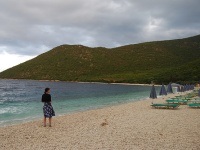
Samos Beaches
The coast of Samos has many beautiful beaches to enjoy as it's a large, lush island. There are at least 20 beaches that tourists and locals recommend. Mykali beach, south of Samos …
Samos Beaches
The coast of Samos has many beautiful beaches to enjoy as it's a large, lush island. There are at least 20 beaches that tourists and locals recommend. Mykali beach, south of Samos town, is covered in white pebbles and lapped by emerald waters and is one of the most popular beaches on the island. On the mountainous northwest coast of Samos, visitors will find the secluded Megalo Seitani beach, which can only be reached on foot and richly rewards those who make the extra effort.
There are a few other beaches on the island that are inaccessible to cars and these tend to be the most private and secluded. The Vlendza beach, just outside the town of Avlakia, has good amenities including sunbeds and umbrellas, as well as a small tavern. Tsamadou beach lies just outside of Kokkari Town and is the only official nudist beach on the island.
The best beach on Samos for children is Psili Ammos beach, as kids love to play in its warm, shallow waters and build sand castles on the shore. It's a very safe beach with calm waters. This long sandy strip also attracts migrant flamingos each year in December and the pink flocks are a delightful sight.
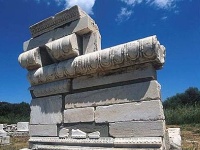
Temple of Hera
The largest Greek temple ever built, the Temple of Hera was one of the essential sanctuaries of ancient Greece, and is now a great sightseeing attraction. It was built near the mou…
Temple of Hera
The largest Greek temple ever built, the Temple of Hera was one of the essential sanctuaries of ancient Greece, and is now a great sightseeing attraction. It was built near the mouth of the Imvrasos river for worship of the goddess who, according to myth, was born and lived there.
Only half of one of its 115 columns stands today, but the bases of the columns and other temple foundations are still visible so it's possible to imagine what the giant temple looked like. The Temple of Hera was constructed over a long period of time; it was added to, renovated or completely rebuilt a number of times over the centuries when it was destroyed by earthquakes or other means.
The oldest building phase identified by archaeologists is the 8th century BC. The very large temple, the ruins of which we can see today, was known as the 'Polycrates Temple'. One of the giant statues from this site can still be seen in the Samos Archaeological Museum, which is a good complement to a trip to the temple ruins as it provides context and information.
Unlike many other archaeological sites in Greece, however, there's some information given at the temple and visitors receive a free guide leaflet upon entry. This temple isn't to be confused with the Temple of Hera at Olympus, where the Olympic Flame is lit for each Olympic Games.
Website www.greeka.com/eastern-aegean/samos/sightseeing/heraion-of-samos/
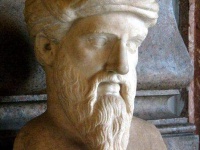
Pythagoras Cave
One of the great attractions on Samos is the cave where Pythagoras lived and worked as a philosopher, mathematician, astrologer, doctor and musician. Very little is actually known …
Pythagoras Cave
One of the great attractions on Samos is the cave where Pythagoras lived and worked as a philosopher, mathematician, astrologer, doctor and musician. Very little is actually known for sure about Pythagoras but legend has it that he used the caves as a refuge from the tyranny of Polycrates.
We know his teachings were mystical as well as mathematical as he was the founder of an esoteric religious movement known as Pythagoreanism. Although some tenets of this religious and philosophical movement are known, for the most part it too is somewhat shrouded in secrecy.
Most of the caves are now open to the public. The site is made up of two caves and two chapels, with 'holy water' dripping from their stalactites, and was used for prayer and teaching as well as shelter. The cave is located on Mount Kerkis, an extinct volcano that forms the second-highest peak in the East Aegean and, although it's located near the base the climb, it may still be a bit difficult for some. The views from the cave are beautiful and there are some great photo opportunities. It's advisable to bring a bottle of water and sensible shoes for the rather steep walk.
Website www.agreekadventure.com/pythagoras-caves-samos/
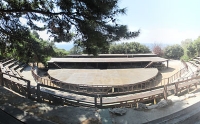
Ancient Theatre of Pythagorion
The Ancient Theatre of Pythagorion sits just below Panagia Spiliani monastery's ruins, though its stage and some seats are all that remains. Still, these remnants hint at how grand…
Ancient Theatre of Pythagorion
The Ancient Theatre of Pythagorion sits just below Panagia Spiliani monastery's ruins, though its stage and some seats are all that remains. Still, these remnants hint at how grand the venue must have been in its time. Today, performers use the site for plays, as well as concerts and modern recitals. Historians and culture buffs should check the calendar for events. Otherwise, Pythagorion is the perfect Mediterranean escape, with a pretty harbour, gorgeous beaches, and the Mediterranean's oldest manmade port standing out as the town's highlights. Attractions in and around the port include the statue of Pythagoras, the Castle of Lykourgos, the Church of Metamorphosis, the Ephpalinos Tunnel and Roman Baths. Visitors who wish to explore a bit further can enjoy sailing excursions to other cities, villages, beaches and ancient sites. The town also has a vibrant nightlife.
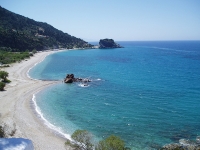
Potami Waterfalls
Children love to visit these beautiful waterfalls on the northeast coast of Samos Island, though it certainly isn't necessary to have children along to enjoy this scenic island att…
Potami Waterfalls
Children love to visit these beautiful waterfalls on the northeast coast of Samos Island, though it certainly isn't necessary to have children along to enjoy this scenic island attraction. Visitors should follow the road west from Karlovassi that leads towards the harbour, which will bring them to the pristine Potami Beach; just over a mile (2km) further visitors will reach a forest and lake, beyond which there's a series of waterfalls.
The rambling walk along the river soon becomes an adventure through the forest leading to the waterfall. Swimming in the small lake is a great way for kids to cool off and there are lovely spots for the folks to sit and relax, or perhaps enjoy a picnic lunch. There are rock valleys and several lovely little pools and waterfalls to explore, as well as some beautiful old trees, interesting rock formations and small bridges. Visitors may even be lucky enough to spot some turtles or other animals.
For the snap happy, this enchanting little forest provides many photo opportunities as well as fun for the whole family. There's no entry fee; visitors simply head into the forest from the beach and enjoy the waterfalls.
Website samos-guide.com/attraction/waterfalls/
Lykourgos Castle
The castle of Lykourgos Logothetis is a magnificent example of defensive architecture. It's situated to the southwest of the port of Pythagorio, and was built at the beginning of t…
Lykourgos Castle
The castle of Lykourgos Logothetis is a magnificent example of defensive architecture. It's situated to the southwest of the port of Pythagorio, and was built at the beginning of the 19th century, playing a vital role in the Greek Revolution against Turkish rule.
It was built, with the help of many locals, out of the remains of ancient buildings and monuments to help repel the invaders and it became the headquarters of the revolutionary movement in Samos and the main asset in their defence against the Ottoman navy. It's named after the local leader of the revolution. There's a temple next door to the castle that commemorates the victory of 6 August 1824 when Samos successfully resisted an attack by the Turks. The anniversary is still celebrated at the church annually.
Lykourgos has wonderful views and many interesting architectural features. The hill on which the castle is located may be the oldest acropolis in Samos, as a number of prehistoric artefacts have been discovered there, making the whole area captivating and rather mysterious. Kids will probably enjoy exploring the castle as much as adults, so it makes a good excursion for the whole family.
Website www.greeka.com/eastern_aegean/samos/samos-excursions/samos-logothetis-castle.htm



